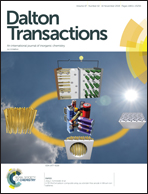Single crystalline thallium rhodium oxide pyrochlore for highly improved round trip efficiency of hybrid Na–air batteries†
Abstract
The development of bifunctional electrocatalysts for the oxygen evolution reaction (OER) and oxygen reduction reaction (ORR) is essential for electrical energy storage systems (EES). Sodium–air (Na–air) batteries are emerging as a new type of EES, due to their high specific energy density and high sodium ion conductivity. However, the undesirable sluggish kinetics of the ORR and OER limit the practical production of rechargeable Na–air batteries. Although pyrochlore oxides (A2B2O7) exhibit great potential for highly-active bifunctional electrocatalysts, the lack of studies regarding A and B-site cations has hindered the development of new pyrochlore catalysts with a comprehensive understanding of the catalytic activity. Here, we demonstrate the use of a single crystalline thallium rhodium pyrochlore oxide (Tl2Rh2O7) as a highly efficient bifunctional electrocatalyst. The high catalytic activity of Tl2Rh2O7 can be attributed to the oxidation of Tl and Rh ions in Tl2Rh2O7 during the ORR and OER. The oxidized Tl and Rh ions can donate their electrons, which easily migrate to the surface and inner layers, following the low-resistance electron pathway during the electrocatalytic reaction. The hybrid Na–air batteries using the prepared Tl2Rh2O7 achieve greatly improved round-trip efficiency with a high power density for 50 cycles.



 Please wait while we load your content...
Please wait while we load your content...